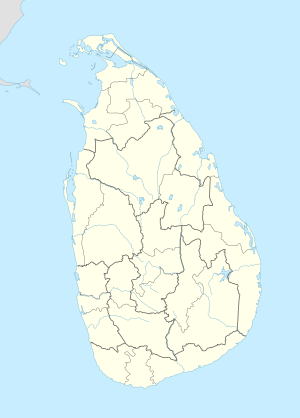Kattankudy mosque massacre
| Kattankudy Mosque Massacre | |
|---|---|
 Kattankudy Kattankudy (Sri Lanka) | |
| Location | Kattankudy, Batticaloa, Sri Lanka[1] |
| Date | 3 August 1990 7:30pm (+6 GMT) |
| Target | Muslims |
Attack type | Armed massacre |
| Weapons | Automatics rifles, hand grenades |
| Deaths | 147 |
| Perpetrators | Liberation Tigers of Tamil Eelam |
The Kattankudy Mosque Massacre was the killing of over 147 Muslim men and boys on 3 August, 1990.[2] Around 30 armed Tamil militants raided four mosques in Kattankudy where over 300 people were prostrating in Isha prayers. The Sri Lankan government, survivors, and observers accuse the Liberation Tigers of Tamil Eelam (LTTE) of committing the crime.[2][3][1] The LTTE denied involvement and never retracted the denial.[4]
Background[]
The Liberation Tigers of Tamil Eelam, is a militant rebel organization which had been fighting the Sri Lankan Civil War since 1975 in order to establish a separate state in the North and East of the country.
Peace talks which began in 1989 broke down ending a 13-month ceasefire. On 11 June the LTTE attacked numerous government targets such as Police stations.[1]
On June 26, LTTE militants looted 93 shops in Kattankudy, burning 3 of them.[5]
On 24 July armed persons murdered four Muslims at a mosque in the Batticaloa District. On 29 July armed persons killed 10 worshippers in Sammanthurai, 25 miles east of the town of Batticaloa.[1] Sri Lankan military officials claimed it was done by the LTTE.[1] They also claimed the LTTE attacked Muslim villages, and burning their shops and homes, on the basis of suspecting them of supporting the government.[1]
Incident[]
On 3 August around 30 heavily armed Tamil rebels crossed a lagoon and entered the town of Kattankudy.[2] An LTTE tax collector, Ranjith Appah, had visited the house of Jinnah Hadjiaar, where LTTE gunmen shot his son-in-law dead.[5] At around 8:10pm, the rebels entered the Meer Jumma Masjid, Hussainiya, Masjid-Jul-Noor and Fowzie Mosques, where hundreds of devotees were attending Friday Isha prayers. The persons were disguised as Muslims to avoid suspicion.[2]
As the civilians knelt in prayer when the Tamil rebels attacked them, spraying automatic fire and hurling hand grenades at the worshippers. Most of the victims were shot in the back or side.[2][1] The rebels fled as Sri Lankan soldiers, notified of the ongoing massacre, arrived at the scene.[1] The army had delayed in reaching the town, citing the possibility of landmines as the reason. This led to some Kattankudy residents suspecting the army was somehow involved in the massacre.[6]
Initial report put the death toll at around 100, but as many of the injured who were rushed to hospital succumbed to their injuries, the final death toll rose to over 147.[2]
Eyewitness accounts[]
Harrowing eyewitness accounts appeared in the international press over the next few days. Speaking to the New York Times, Mohammed Ibrahim, a 40-year-old businessman said:
"I was kneeling down and praying when the rebels started shooting. The firing went on for 15 minutes. I escaped without being hit and found myself among bodies all over the place."[1]
Mohammed Arif, a 17-year-old student who also survived the massacre told the New York Times:
"Before I escaped from a side door and scaled a wall, I saw a Tiger rebel put a gun into the mouth of a small Muslim boy and pull the trigger."[1]
Aftermath[]
Then Sri Lankan President Ranasinghe Premadasa directed Sri Lanka Air Force helicopters to rush the injured to hospitals for urgent treatment. They continued to ferry the injured to hospitals throughout the next morning.[2] Soon after the massacre, government troops launched an operation in the area to capture the killers. One of the helicopters involved in the search shot at two boat loads of LTTE rebels off the sea at Kattankudi. They were believed to be fleeing to India following the massacre. Casualties amongst the rebels were not confirmed.[2]
The incident was the worst massacre of civilians since the resumption the conflict on 11 June.[2] All the victims were buried in a cemetery at the Meera Jumma Mosque, where mourners dug a long common grave for a row of coffins.[1]
LTTE denied responsibility and alleged that it was done by the government to get arms from the Islamic countries.[7]
References[]
- ^ a b c d e f g h i j k "Tamils Kill 110 Muslims at 2 Sri Lankan Mosques". The New York Times. 5 August 1990. Retrieved 2 May 2019.
- ^ a b c d e f g h i Xinhua, 147 Muslims Massacred by Tamil "Tigers" in Sri Lanka, Colombo, August 3, 1990
- ^ Sri Lanka: The Northeast: Human rights violations in a context of armed conflict Archived 2009-02-14 at the Wayback Machine
- ^ Trawick, Margaret (1999). Enemy Lines: Warfare, Childhood, and Play in Batticaloa. University of California Press. p. 205. ISBN 978-0-520-24515-0. OCLC 70866875.
- ^ a b "Welcome to UTHRJ: Report 7, Chapter 2". www.uthr.org. Retrieved 27 April 2019.
- ^ Sriskandarajah, A. R. (2017). Government and Politics in Sri Lanka: Biopolitics and Security. Taylor & Francis. p. 82. ISBN 9781138290976.
- ^ Hodgin, Deanna (22 October 1990). "An Ethnic Inferno in Island Paradise". Insight on the News.
- Attacks on civilians attributed to the Liberation Tigers of Tamil Eelam
- Attacks on mosques in Asia
- August 1990 events in Asia
- Civilian massacres in Sri Lanka
- Liberation Tigers of Tamil Eelam attacks in Eelam War II
- Massacres in religious buildings and structures
- Massacres in 1990
- Mass murder of Sri Lankan Muslims
- Massacres of men
- Incidents of violence against boys
- Terrorist incidents in Sri Lanka in 1990
- Violence against children
- Violence against men in Asia